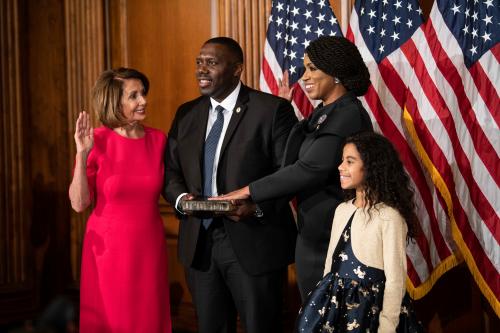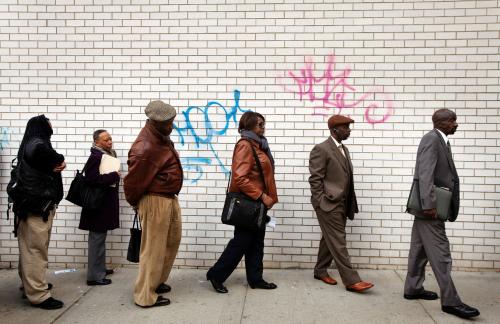Since President Donald Trump dispensed his racist tweets on July 14, asserting that four U.S. congresswomen of color “go back and help fix the totally broken and crime infested places from which they came,” many analysts have wrongly declared that his patently vile and illogical statements (three of the congresswomen were born in the U.S.) are separate and distinct from supposedly real public policy issues and agendas.
One Washington Post columnist stated the President motives were clear, to “create chaos, distract the masses, look mad, take care of business.” The Post columnist is not alone. The four women who Trump targeted, Reps. Alexandria Ocasio-Cortez (N.Y.), Ilhan Omar (Minn.), Ayanna Pressley (Mass.) and Rashida Tlaib (Mich.), held a press conference the next day and declared the clearly racist comments a distraction.
Policy has historically come in many forms, including practices to influence public behavior
Policy encompasses written legislation, mandates, acts, and regulations in governments, institutions and businesses to influence behaviors. Those who charge that Trump’s bigoted vitriol is a distraction wrongly limits policy to those written, concrete forms. Policy also comes in the form of practice—regularly exercised procedures that are also used to influence behaviors. Many policies are unwritten or are implied through communicated rhetoric. Many voters make decisions and vote on racist rhetoric just as they would act on issues of foreign policy or social security.
Racism should never be diminished as a distraction—history shows well that the strategic deployment of bigotry is a default practice used to undercut democracy. Inserting nativist, xenophobic language has been the reliable prelude to codifying bigotry into law.
The Know-Nothing Party of the 1800s worked to prevent immigrants and Catholics from holding elected office. The party, which at its peak included more than 100 elected congressman and eight governors, rose to power with nativist propaganda. One poster read, “All Catholics and all persons who favor the Catholic Church are…vile imposters, liars, villains, and cowardly cutthroats.”
Racism should never be diminished as a distraction—history shows well that the strategic deployment of bigotry is a default practice used to undercut democracy.
Racial attitudes baked in Baltimore’s housing policy in 1910 became a model for racial housing covenants across the country. Baltimore’s then mayor J. Barry Mahool’s dim view of blacks was laid bare in his explanation of the policy. “Blacks should be quarantined in isolated slums in order to reduce the incidence of civil disturbance, to prevent the spread of communicable disease into the nearby White neighborhoods, and to protect property values among the White majority.”
“The Japanese race is an enemy race and while many second and third generation Japanese born on American soil, possessed of American citizenship, have become ‘Americanized,’ the racial strains are undiluted,” wrote General John L. DeWitt, head of the U.S. Army’s Western Defense Command on February 14, 1942. “The very fact that no sabotage has taken place to date is a disturbing and confirming indication that such action will be taken.” Five days later, President Franklin D. Roosevelt signed an executive order that permitted “the removal and incarceration of any and all persons from areas of the country deemed vulnerable to attack or sabotage.” As a result, over 100,000 people were placed in internment camps in one of the great race/ethnicity-based stains in American history.
Most recently, before the Trump administration instituted the policy of separating families at the Mexico border, he laid the groundwork on the campaign trail. “When Mexico sends its people, they’re not sending the best,” Trump said during his presidential announcement speech in 2015. “They’re not sending you, they’re sending people that have lots of problems and they’re bringing those problems. They’re bringing drugs, they’re bringing crime. They’re rapists and some, I assume, are good people, but I speak to border guards and they’re telling us what we’re getting.”
Racist rhetoric continues to catalyze racist policy
Establishing that black, brown, and Asian people don’t belong or aren’t real Americans is how our democracy ended up with legal segregation, internment camps, housing discrimination, racially biased criminal justice systems and immigration policies. Trump clearly didn’t create this practice; he adopted it from his predecessors. Those who study policy and dismiss racism as a distraction aid and abet in its proliferation.
Charging that Americans should “go back” is to say certain people are not real members of a community and can be discriminated against. Telling fellow Americans to go back is to signal to others that you espouse a belief in a hierarchy, which obviously flies in the face of democracy. Dismissing racism as anything but a policy position and/or practice renders any serious analysis of supposed real policy hollow.
Establishing that black, brown, and Asian people don’t belong or aren’t real Americans is how our democracy ended up with legal segregation, internment camps, housing discrimination, racially biased criminal justice systems and immigration policies.
In June of 2018 before golfing at his course in Virginia, Trump tweeted “We cannot allow all of these people to invade our Country,” asserting that we should abandon due process laws for refugees who seek asylum in America. He continued, “When somebody comes in, we must immediately, with no Judges or Court Cases, bring them back from where they came.” The “bring them back” language wasn’t simply a statement about his beliefs in immigration. Trump signaled then, as he implied with his more recent tweets about the U.S. congresswomen and follow-up comments this week, that some people regardless of immigration status don’t belong.
By downplaying racism as a distraction, we assist in the normalization of racism. Apologists for the president’s racist tweets said he was referring to socialists—as if that would make them less American. A day after Trump’s racist tweets toward the four congresswoman, Sen. Steve Daine (R-Mont.), who is up for re-election in 2020, tweeted, “Montanans are sick and tired of listening to anti-American, anti-Semite, radical Democrats trash our country and our ideals. This is America. We’re the greatest country in the world. I stand with @realdonaldtrump.” At a Trump campaign rally in North Carolina on July 18, crowds chanted “send her back” after deriding Rep. Omar. And local examples abound throughout the country of the trickle-down effect of racist rhetoric.
Giving racism short shrift is a form of white privilege that helps maintain racial hierarchies and racial disparities. Softening or discounting bigotry is why economists and pundits can deem an economy productive while largely ignoring immense racial disparities. It’s why when Democratic centrists talk of the middle class, they largely stay away from conversations about wealth inequality and reparations.
No, racism is never a distraction. It is the policy of the privileged and the enemy of the just.





Commentary
Racism is not a distraction; It’s policy
July 19, 2019